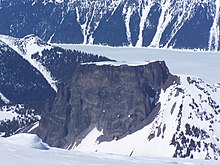Ridge
This article has multiple issues. Please help or discuss these issues on the talk page. (Learn how and when to remove these template messages)
|

A mountain ridge in Japan

A stratigraphic ridge within the Appalachian Mountains.

The edges of tuyas can form ridges.

Pirin Mountain main ridge - view from Koncheto knife-edge ridge towards the pyramidal peaks Vihren and Kutelo
A ridge or a mountain ridge is a geographical feature consisting of a chain of mountains or hills that form a continuous elevated crest for some distance. The sides of the ridge slope away from narrow top on either side. The lines along the crest formed by the highest points, with the terrain dropping down on either side, are called the ridgelines. Ridges are usually termed hills or mountains as well, depending on size.
Types[]
There are several main types of ridges:
- Dendritic ridge: In typical dissected plateau terrain, the stream drainage valleys will leave intervening ridges. These are by far the most common ridges. These ridges usually represent slightly more erosion resistant rock, but not always – they often remain because there were more joints where the valleys formed or other chance occurrences. This type of ridge is generally somewhat random in orientation, often changing direction frequently, often with knobs at intervals on the ridge top.
- Stratigraphic ridge: In places such as the Ridge-and-Valley Appalachians, long, even, straight ridges are formed because they are the uneroded remaining edges of the more resistant dipping strata that were folded laterally. Similar ridges have formed in places such as the Black Hills, where the ridges form concentric circles around the igneous core. Sometimes these ridges are called "hogback ridges".
- Oceanic spreading ridge: In tectonic spreading zones around the world, such as at the Mid-Atlantic Ridge, the volcanic activity forms new land between tectonic boundaries creating volcanic ridges at the spreading zone. Isostatic settling and erosion gradually reduces the elevations moving away from the zone.
- Crater ridges: Large meteorite strikes typically form large impact craters bordered by circular ridges.
- Volcanic crater/caldera ridges: Large volcanoes often leave behind a central crater/caldera bordered by circular ridges.
- Fault ridges: Faults often form escarpments. Sometimes the tops of the escarpments form not plateaus but slope back so that the edges of the escarpments form ridges.
- Dune ridges: In areas of large-scale dune activity, certain types of dunes result in sand ridges.
- Moraines and eskers: Glacial activity may leave ridges in the form of moraines and eskers. An arête is a thin ridge of rock that is formed by glacial erosion.
- Volcanic subglacial ridges: Many subglacial volcanoes create ridge-like formations when lava erupts through a thick glacier or ice sheet.
- Shutter ridges: A shutter ridge is a ridge that has moved along a fault line, blocking or diverting drainage. Typically, a shutter ridge creates a valley corresponding to the alignment of the fault that produces it.
- Pressure ridges: Also known as a tumuli, usually develops in lava flows especially when slow-moving lava beneath a solidified crust wells upward. The brittle crust usually buckles to accommodate the inflating core of the flow, thus creating a central crack along the length of the tumulus.[1] An Ice pressure ridge develops in an ice cover as a result of a stress regime established within the plane of the ice.
See also[]
| Wikimedia Commons has media related to Ridges. |
- Fall line (topography) – Mountain or hill direction
- Hill chain
- Mountain chain
- Mountain range – Geographic area containing several geologically related mountains
- Tectonic uplift – The portion of the total geologic uplift of the mean earth surface that is not attributable to an isostatic response to unloading
- Ridge detection
- Ridge (differential geometry)
References[]
- ^ "How Volcanoes Work - lava flow features". www.geology.sdsu.edu. Retrieved 2019-01-13.
External links[]
- Norsk Geologisk Tidsskrift, Volume 69 Universitetsforlaget, 1989, page 40 https://books.google.com/books?id=dXK7AAAAIAAJ
- Physical Geography: Introduction To Earth, page 164
Categories:
- Ridges
- Montane ecology
- Erosion landforms
- Slope landforms
- Mountains
- Oronyms
